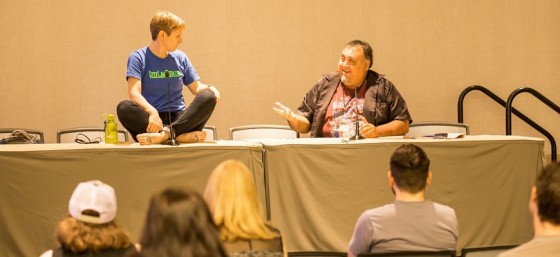
11/6/2015 – Taurid Meteor Shower – Joshua Tree , CA by Channone Arif from Flickr (Creative Commons License)
In light of the recent lawsuit between CBS and Paramount Pictures and a Star Trek fan film creator, CBS and Paramount released guidelines regarding fan-created films.
Previously, fan fiction movies were limited to camcorders and sets people created in their backyards, but now with computer animation and other technology, a fan could create an impressive work of fan fiction. You can see some earlier Trek fan fiction on the documentary Trekkies.
A friend asked me to weigh in on these guidelines. As a die-hard Star Trek fan, my legal interpretation may be slightly biased in favor of promoting fandom. Below are the guidelines in full with my comments in italics:
CBS and Paramount Pictures are big believers in reasonable fan fiction and fan creativity (I’m glad you support fan art/fiction. Star Trek is known for inviting fan-submitted scripts, but what do you mean by “reasonable?”), and, in particular, want amateur fan filmmakers to showcase their passion for Star Trek. Therefore, CBS and Paramount Pictures will not object to, or take legal action against, Star Trek fan productions that are non-professional and amateur and meet the following guidelines. (It’s nice when people tell you how not to get sued.)
Guidelines for Avoiding Objections:
1. The fan production must be less than 15 minutes for a single self-contained story, or no more than 2 segments, episodes or parts, not to exceed 30 minutes total, with no additional seasons, episodes, parts, sequels or remakes. Is this because you don’t want fan fiction to compete with the TV series and movies? I wonder if someone is less likely to make significant money from a one-off video vs. a series. I wonder if the copyright holder would have objected if Melissa Hunter only made one Adult Wednesday Addams video instead of two seasons.)
2. The title of the fan production or any parts cannot include the name “Star Trek.” However, the title must contain a subtitle with the phrase: “A STAR TREK FAN PRODUCTION” in plain typeface. The fan production cannot use the term “official” in either its title or subtitle or in any marketing, promotions or social media for the fan production. (This makes sense from a trademark perspective. With brands creating content in various genres, it’s important to avoid confusing viewers about what is/is not made by the brand vs fans.)
3. The content in the fan production must be original, not reproductions, recreations or clips from any Star Trek production. If non-Star Trek third party content is used, all necessary permissions for any third party content should be obtained in writing. (This makes sense because of copyright. It’s ok to copy ideas, but not the original work itself. This may be overstepping a little bit depending on how they define “recreations.”)
4. If the fan production uses commercially-available Star Trek uniforms, accessories, toys and props, these items must be official merchandise and not bootleg items or imitations of such commercially available products. (I understand that they want to promote their partners and don’t want fans being misled. However, it makes more sense to require disclosure of sources of props and costumes. Some fans prefer to have a tailor custom-make uniforms instead of buying them from commercial sources. And thank you for calling them uniforms, not costumes – as a fan and Starfleet officer myself, I appreciate that.)
5. The fan production must be a real “fan” production, i.e., creators, actors and all other participants must be amateurs, cannot be compensated for their services, and cannot be currently or previously employed on any Star Trek series, films, production of DVDs or with any of CBS or Paramount Pictures’ licensees. (What?! This seems overreaching and overly broad, especially considering that non-compete agreements are not permitted in California. Past and current employees can have non-disclosure agreements that limit their participation in other projects. Even a hobbyist has to pay for certain things – like a musician paying for studio time.)
6. The fan production must be non-commercial (This makes sense. Many artists approve of fan art as long as the person isn’t selling their work.):
- CBS and Paramount Pictures do not object to limited fundraising for the creation of a fan production, whether 1 or 2 segments and consistent with these guidelines, so long as the total amount does not exceed $50,000, including all platform fees, and when the $50,000 goal is reached, all fundraising must cease. (Thank you for understanding that hobbyists have expenses – despite your contradictory term above.)
- The fan production must only be exhibited or distributed on a no-charge basis and/or shared via streaming services without generating revenue. (Ok – so you can’t submit your video to film festivals or run ads on it if you post on YouTube.)
- The fan production cannot be distributed in a physical format such as DVD or Blu-ray. (This makes sense given current technology. They want to protect their intellectual property.)
- The fan production cannot be used to derive advertising revenue including, but not limited to, through for example, the use of pre or post-roll advertising, click-through advertising banners, that is associated with the fan production. (Fair enough.)
- No unlicensed Star Trek-related or fan production-related merchandise or services can be offered for sale or given away as premiums, perks or rewards or in connection with the fan production fundraising. (This makes sense in terms of protecting their intellectual property, and also makes it more challenging to use fundraising sites.)
- The fan production cannot derive revenue by selling or licensing fan-created production sets, props or costumes. (Agreed. This makes sense.)
7. The fan production must be family friendly and suitable for public presentation. Videos must not include profanity, nudity, obscenity, pornography, depictions of drugs, alcohol, tobacco, or any harmful or illegal activity, or any material that is offensive, fraudulent, defamatory, libelous, disparaging, sexually explicit, threatening, hateful, or any other inappropriate content. The content of the fan production cannot violate any individual’s right of privacy. (I understand no porn, but no illegal activities? What are the bad guys supposed to do? Even Star Trek episodes and films depictions of tobacco and alcohol and the films contain the occasional swear word.)
8. The fan production must display the following disclaimer in the on-screen credits of the fan productions and on any marketing material including the fan production website or page hosting the fan production:
“Star Trek and all related marks, logos and characters are solely owned by CBS Studios Inc. This fan production is not endorsed by, sponsored by, nor affiliated with CBS, Paramount Pictures, or any other Star Trek franchise, and is a non-commercial fan-made film intended for recreational use. No commercial exhibition or distribution is permitted. No alleged independent rights will be asserted against CBS or Paramount Pictures.” (This makes sense, but the last sentence suggests that CBS and Paramount may be able to use fan-created content without obtaining the creators’ permission.)
9. Creators of fan productions must not seek to register their works, nor any elements of the works, under copyright or trademark law. (What about the fans’ rights to protect their original works of authorship and their brands that don’t infringe on CBS or Paramount’s rights?)
10. Fan productions cannot create or imply any association or endorsement by CBS or Paramount Pictures. (Agreed.)
CBS and Paramount Pictures reserve the right to revise, revoke and/or withdraw these guidelines at any time in their own discretion. These guidelines are not a license and do not constitute approval or authorization of any fan productions or a waiver of any rights that CBS or Paramount Pictures may have with respect to fan fiction created outside of these guidelines. (This makes sense as long as CBS and Paramount don’t change the rules and go after a fan film creator who reasonably complied with the guidelines as written at that time.)
I appreciate that CBS and Paramount Pictures’ desire to protect their intellectual property and that put out guidelines to further this goal, but I wish they would be more fan-friendly. Hopefully this is only an over-zealous reaction to the recent lawsuit and not a sign of future legal battles between Star Trek and their fans.
If you have questions about the legalities of fan art/fiction or you just want to geek out about Star Trek, you can contact me directly or connect with me on Twitter, Facebook, YouTube, or LinkedIn. You can also get access to more exclusive content that is available only to people on my mailing list, by subscribing here.




